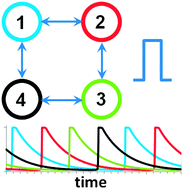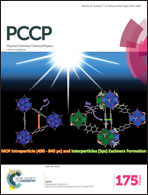Dynamical regimes of four almost identical chemical oscillators coupled via pulse inhibitory coupling with time delay
Abstract
The dynamic regimes in networks of four almost identical spike oscillators with pulsatile coupling via inhibitor are systematically studied. We used two models to describe individual oscillators: a phase-oscillator model and a model for the Belousov–Zhabotinsky reaction. A time delay τ between a spike in one oscillator and the spike-induced inhibitory perturbation of other oscillators is introduced. Diagrams of all rhythms found for three different types of connectivities (unidirectional on a ring, mutual on a ring, and all-to-all) are built in the plane Cinh–τ, where Cinh is the coupling strength. It is shown analytically and numerically that only four regular rhythms are stable for unidirectional coupling: walk (phase shift between spikes of neighbouring oscillators equals the quarter of the global period T), walk-reverse (the same as walk but consecutive spikes take place in the direction opposite to the direction of connectivity), anti-phase (any two neighbouring oscillators are anti-phase), and in-phase oscillations. In the case of mutual on the ring coupling, an additional in-phase–anti-phase mode emerges. For all-to-all coupling, two new asymmetrical patterns (two-cluster and three-cluster modes) have been found. More complex rhythms are observed at large Cinh, when some oscillators are suppressed completely or generate smaller number of spikes than others.


 Please wait while we load your content...
Please wait while we load your content...